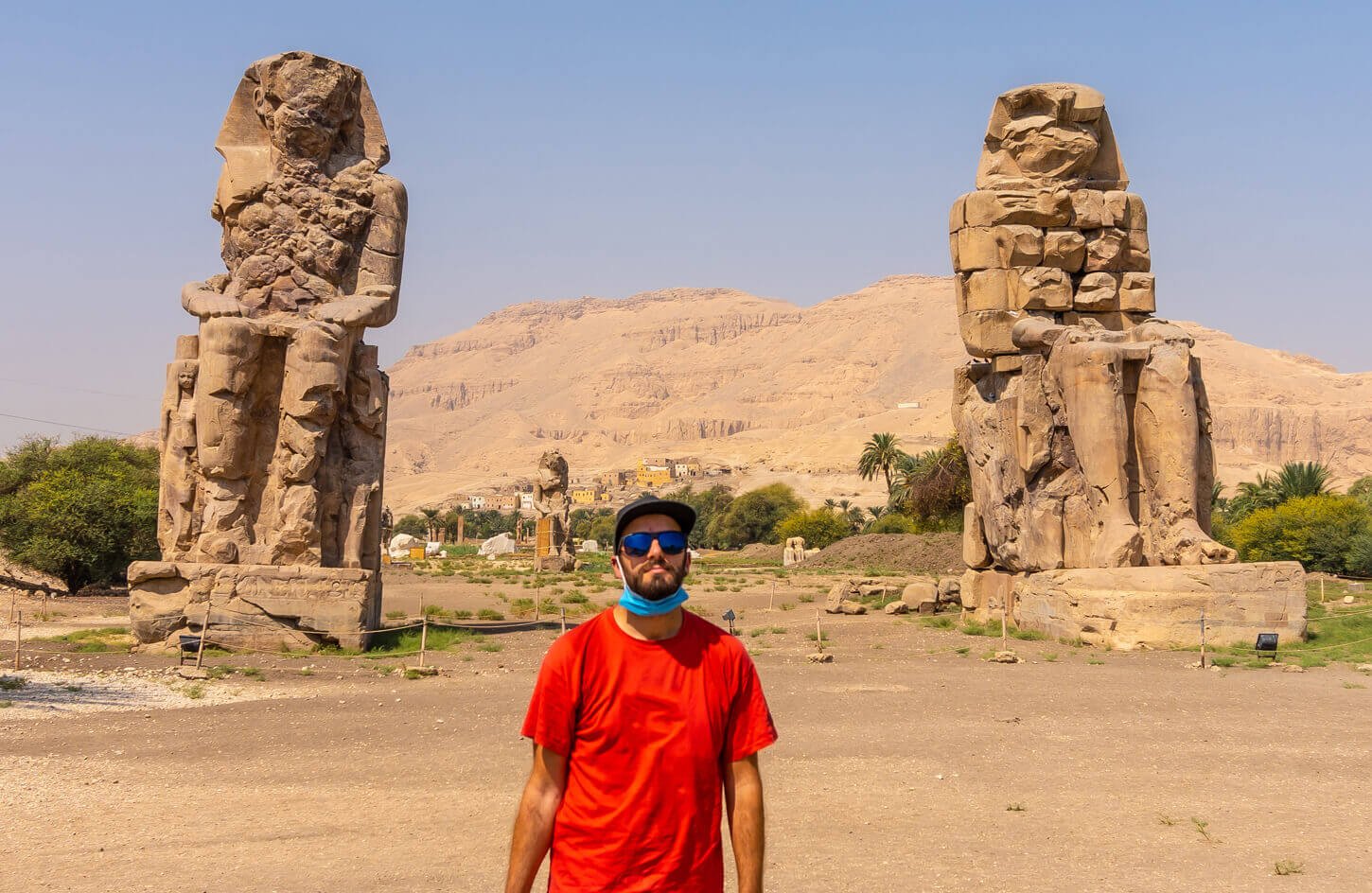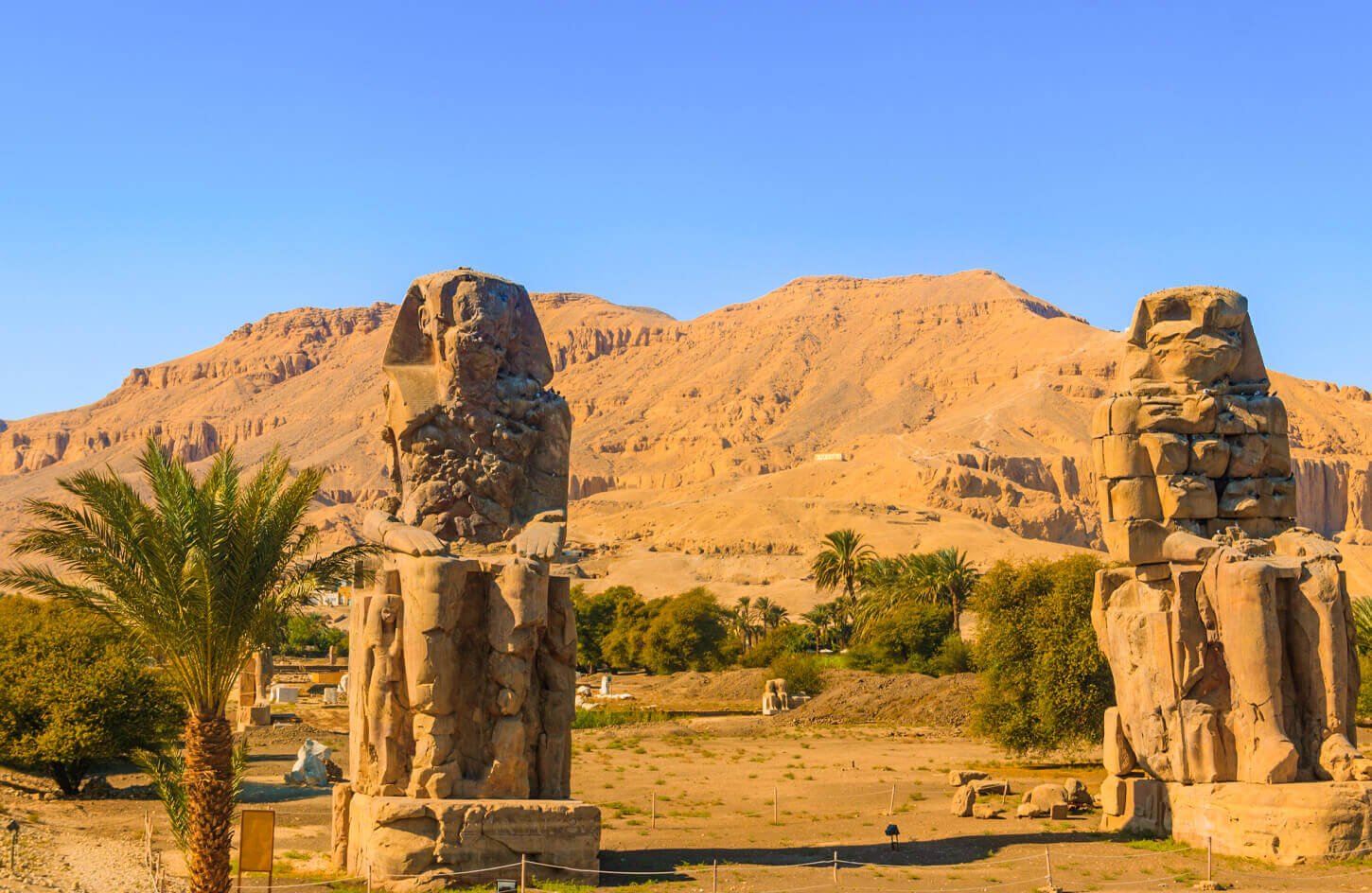The Colossi of Memnon stands proudly on the western bank of the Nile River, near the modern-day city of Luxor in Egypt. With their size and enigmatic presence, these colossal statues have captivated visitors for centuries. This comprehensive guide delves into the rich history, cultural significance, and intriguing legends surrounding the Colossi of Memnon.
The Colossi of Memnon are two massive stone statues that depict Pharaoh Amenhotep III, who reigned during the 14th century BCE. These towering figures once guarded the entrance to Amenhotep III’s mortuary temple.
Significance and Cultural Context of the Colossi of Memnon
During the reign of Amenhotep III, Egypt experienced a period of great prosperity and artistic achievement. The Colossi of Memnon played a crucial role in religious rituals and symbolized the pharaoh’s divine power and eternal presence.
Located on the west bank of the Nile, near the Valley of the Kings, the Colossi of Memnon face the rising sun. Each statue stands over 18 meters (60 feet) tall and is carved from quartzite sandstone. Their imposing presence is a testament to ancient Egypt’s engineering and artistic skill.

Historical Background
The reign of Amenhotep III
Amenhotep III, one of Egypt’s most illustrious pharaohs, ruled during the prosperous New Kingdom period. He initiated ambitious building projects, including constructing his mortuary temple and creating the Colossi of Memnon.
Purpose and symbolism of the Colossi
The Colossi of Memnon were erected to guard Amenhotep III’s mortuary temple and to serve as a focal point for religious ceremonies and offerings. They represented the pharaoh’s connection to the gods and his divine status as the intermediary between the mortal and divine realms.
Construction and original appearance
These colossal statues were crafted with remarkable precision and skill. Scholars believe that they were carved on-site from the local quartzite sandstone. Originally, the statues were adorned with intricate details, such as royal regalia and hieroglyphic inscriptions that extolled the pharaoh’s achievements.
Description of the Colossi
Physical characteristics and dimensions
The Colossi of Memnon are awe-inspiring in their grandeur. Each statue stands approximately 18.4 meters (60 feet) tall and weighs an estimated 720 tons. They depict Amenhotep III seated on a throne, with his hands resting on his knees, conveying a sense of regal authority and tranquility.
Materials used in construction
The statues were meticulously carved from quartzite sandstone, a durable material withstood the test of time. The stone’s reddish-brown hue adds to the statues’ visual allure, especially during the golden hours of sunrise and sunset.
Decorative elements and inscriptions
Initially, the Colossi of Memnon featured elaborate details and decorations. Hieroglyphic inscriptions covered the statues, recounting the pharaoh’s accomplishments and invoking blessings from the gods. Traces of vibrant pigments, which once adorned the statues, can still be seen on certain parts of the statues today.
Archaeological Discoveries and Restoration
Rediscovery and exploration in modern times
After falling into obscurity, the Colossi of Memnon was rediscovered by European explorers in the 19th century. Excavations and archaeological surveys have shed light on these statues’ historical context and significance.
Damage and restoration efforts
Over the centuries, the Colossi of Memnon have suffered natural wear and human-induced damage. Earthquakes, flooding, and looting have taken their toll. However, numerous restoration projects have been undertaken to preserve and protect these ancient treasures.
Preservation challenges and ongoing maintenance
Preserving the Colossi of Memnon presents ongoing challenges due to the statues’ exposure to the elements and tourism pressures. Conservation efforts aim to balance the preservation of the original structures with accessibility for visitors worldwide.

Significance and Cultural Influence
Religious and mythological associations
The Colossi of Memnon became objects of veneration and were associated with various myths and legends. According to one ancient Greek legend, the statues emitted haunting sounds at dawn, known as the “Vocal Memnon,” which were interpreted as the statue greeting the mother of Memnon, a fallen hero of the Trojan War.
Tourism and visitor experience
The Colossi of Memnon attract tourists from across the globe, who marvel at their sheer scale and historical significance. Visitors can explore the surrounding archaeological sites, including the nearby Valley of the Kings and Hatshepsut’s Temple.
Artistic and literary depictions
The Colossi of Memnon have inspired countless artists, writers, and poets throughout history. They have been depicted in paintings, engravings, and literature, immortalizing their iconic presence in the annals of human creativity.
Controversies and Legends
The “Vocal Memnon” phenomenon
The “Vocal Memnon” myth persisted for centuries, with numerous visitors claiming to hear the statues produce sounds. However, investigations have revealed that these sounds likely resulted from the statues’ structure and temperature changes at sunrise.
Ancient and modern theories surrounding the statues
Scholars and archaeologists have put forth various theories regarding the construction techniques, purpose, and symbolism of the Colossi of Memnon. Some propose that the statues were intended to ward off evil spirits, while others argue they served as protective guardians for the pharaoh’s mortuary temple.
Popular myths and legends associated with the Colossi
From ancient tales of the “Vocal Memnon” to modern legends surrounding hidden treasures, the Colossi of Memnon continues to capture people’s imaginations worldwide. These enduring myths add an air of mystery and intrigue to these magnificent statues.
Conclusion
The Colossi of Memnon is a remarkable testament to ancient Egypt’s grandeur and artistic achievements. They embody the power and divinity of Pharaoh Amenhotep III and serve as a gateway to the region’s rich cultural heritage.
Even in the modern era, the Colossi of Memnon fascinates and captivates visitors. They are a testament to the enduring legacy of ancient Egypt and serve as a reminder of the remarkable civilizations that once thrived along the banks of the Nile.
As we stand before the colossal statues, we are transported back in time, marveling at the craftsmanship and artistry of the ancient Egyptians. The Colossi of Memnon inspire us to ponder the mysteries of the past and appreciate the cultural heritage that shapes our world today.
Related Articles You Might Find Interesting:


0 Comment